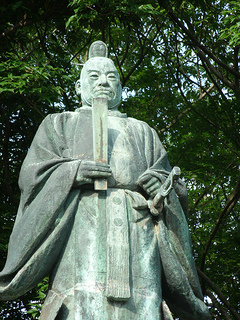Ii Naosuke

- Born: 1815
- Died: 1860/3/3
- Titles: 大老 (Tairô, 1858/4/23-1860/3/3), 掃部頭 (Kamon-no-kami)
- Japanese: 井伊直弼 (Ii Naosuke)
Ii Naosuke was a prominent Tairô of the Bakumatsu period, known for his support of ending the maritime restrictions of the Edo period and "opening" the country, and for his engineering of the Ansei Purges in which he purged from the government a great many shogunate officials belonging to rival factions.
Born at the Keyakigoten, the lord's private residence within Hikone castle, Naosuke became lord of Hikone han at the age of 36. He was named Tairô in 1858, and was a strong supporter of Hotta Masayoshi's having negotiated and agreed to the Treaty of Amity and Commerce (Harris Treaty).
Among his many activities as Tairô, in addition to the Ansei Purges, Naosuke suggested the succession of Tokugawa Iemochi to the position of shogun following the death of Tokugawa Iesada, and restored Manabe Akikatsu to the rôjû after disagreements with Mizuno Tadakuni forced Akikatsu to retire from the position.
Death
Naosuke was killed by Mito han loyalists outside the Sakuradamon (Sakurada Gate) of Edo castle on 1860/3/3, in what is known as the Sakuradamongai no hen or Sakuradamongai Incident. Following his death, in accordance with common practice after the death of a lord, heirloom swords and other treasured possessions of Naosuke's were distributed to certain prominent lords (including close relatives), as "reminders" or "relics" of the late lord.[1]
Legacy
Former retainers of Hikone domain proposed that a statue of Naosuke be erected in 1881, but the Meiji government had declared Naosuke a "traitor to the Court," and was squarely opposed to celebrating him in such a fashion. By 1909, however, attitudes had changed, and the government was now supportive of celebrating figures such as Naosuke who helped "open" up Japan; a statue was erected of him in Yokohama in what is now known as Kamon-yama Park, after Naosuke's honorary title Kamon-no-kami.[2]
References
- Plaques on-site at Hikone castle.
- ↑ Mori Yoshikazu 母利美和, "Buke girei to tachi" 武家儀礼と太刀, Gekkan bunkazai (1989/8), 35-36. Lords who received swords from the Ii at that time included the shogun, as well as Rôjû Andô Nobumasa (lord of Iwakidaira), Nakagawa Hisataka (relative, lord of Oka), Sakakibara Masakiyo (relative, lord of Takada han), former kanpaku Kujô Naotada, Naitô Kii-no-kami (relative, lord of Nobeoka), Ii Hyôbu-dayû (branch family, lord of Yoita han), and Matsudaira Yoritoshi (relative, lord of Takamatsu).
- ↑ Sven Saaler, "Public Statuary and Nationalism in Modern and Contemporary Japan," Asia-Pacific Journal: Japan Focus 15:20:3 (Oct 15, 2017), 1-2.